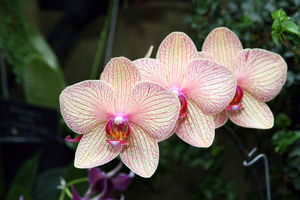Member Plants
Upcoming Global Events

24th World Orchid Conference, Germany
There are currently no photos of plants of
Cirrhopetalum japonicum
for sale by members of ORCHIDS.ORG.
Below are other recent plants for sale:
Log in to Add a Comment

Author is Ken Slump, posted almost 5 years ago
A 12-Step Plan for Becoming a Successful Orchid Grower
IF YOU ARE NEW TO THE ORCHID hobby and perhaps feel you are not enjoying the success with your plants that you had hoped for, read throug...
Read More

Author is Roy Tokunaga, posted over 5 years ago
We take water for granted. It falls out of the sky. It flows from the faucet. Oahu city water is considered good for growing Orchids. We use it without thought or concern.
If you study orch...
Read More
Do you have a plant for sale or trade
which you cannot ship or do not want to bother shippping?
No problem.
Click here to make a local-only offer.
It's a free service to our members.
Orchid Species: Cirrhopetalum japonicum
Kew currently accepted name is Bulbophyllum japonicum
Cirrhopetalum japonicum is an orchid species identified by Makino in 1891. Culture information and photos for this orchid are commonly detailed under the currently accepted name of Bulbophyllum japonicum.
Genus
Cirrhopetalum (Cirr.)
Grex
japonicum
Parents
Species
Author
Makino
Year
1891
ORIGIN: Found in Japan, the Ryukyus, China and Taiwan in broad leaved forests at elevations of 600 to 1500 meters.
DESCRIPTION: Mini-miniature sized, cool to cold growing, miniature epiphyte best mounted on treefern and given a well-shaded humid environment with moderate water, year round that has closely spaced to distant, ovoid pseudobulbs carrying a single, apical, fleshy, oblong-lanceolate, tapering to a shortly petiolate base leaf that is acute at both the apex and the base and blooms in the late spring on a slender, 1 5/8 [4 cm] long, erect inflorescence that is shorter than the leaf and has an apical umbel of a few to several flowers. This species grows well in cool to warm temperatures, partial shade and ample water if mounted on tree fern or grown in a pot with a free draining medium.
FLOWER SIZE: 1/8 inch [5 mm] -- information provided by Jay Pfahl, author of the Internet Orchid Species Encyclopedia (IOSPE).
DESCRIPTION: Mini-miniature sized, cool to cold growing, miniature epiphyte best mounted on treefern and given a well-shaded humid environment with moderate water, year round that has closely spaced to distant, ovoid pseudobulbs carrying a single, apical, fleshy, oblong-lanceolate, tapering to a shortly petiolate base leaf that is acute at both the apex and the base and blooms in the late spring on a slender, 1 5/8 [4 cm] long, erect inflorescence that is shorter than the leaf and has an apical umbel of a few to several flowers. This species grows well in cool to warm temperatures, partial shade and ample water if mounted on tree fern or grown in a pot with a free draining medium.
FLOWER SIZE: 1/8 inch [5 mm] -- information provided by Jay Pfahl, author of the Internet Orchid Species Encyclopedia (IOSPE).
Other Names
| Genus Name | Genus | Grex Name | Year | Author | |
|---|---|---|---|---|---|
| Add+ | Bulbophyllum | Bulb | japonicum | 1910 | (Makino) Makino |
| Add+ | Bulbophyllum | Bulb | inabae | 1914 | Hayata |
| Add+ | Cirrhopetalum | Cirr | inabae | 1917 | (Hayata) Hayata |
Featured Site Articles
Read Latest Articles
Beginners Start Here

Water: The Most Important Nutrient
New Topics
- Carol Holdren asked question Grow Tent in the Garage in category General Discussion
- David George asked question rlc Caotan Beauty found at Home Depot in category Cattleya Alliance
- Kristin Dorris asked question Odontocidium Orchid fungus? in category General Discussion
- Maria Fernandez asked question Wild. Lisa Devos in category Dendrobiums
New Comments
- Dr. Florian Wolf commented on topic "Wild. Lisa Devos" by Maria Fernandez
- Michael Valcarcel commented on member plant Rlc. Chief Takanaka by Walceli Muniz Valverde
- Michael Valcarcel commented on member plant Rlc. Montana Spirit by Michael Valcarcel
- Michael Valcarcel commented on member plant Ctt. Blazing Sun by Michael Valcarcel
- Michael Valcarcel commented on member plant Bc. Spotted Clown by Michael Valcarcel
- Maria Skrypnyk commented on member plant Yamadara Redland Sunset by Maria Skrypnyk
- André Pessina commented on topic "Odontocidium Orchid fungus?" by Kristin Dorris
- Linda Hartman commented on topic "Image of a plant please" by Leshya Perkins
- Paul Reavis commented on orchid Milt. Kismet
- Christiaan Viljoen commented on member plant Psh. fragrans by Christiaan Viljoen
- Christiaan Viljoen commented on member plant Z. maculatum by Christiaan Viljoen
- Christiaan Viljoen commented on member plant C. Gaskell-Pumila 'Azure Star' by Christiaan Viljoen
- Robert H. Findlay commented on member plant Rlc. Joy Sokabe var. Volcano Queen by Sally K
- James Lunsford commented on member plant Lc. Sagarik Wax 'African Beauty AMO/AOS x Blc. Cherry Suisse'Kauai' HCC/AOS var. Cattlyea 'Hybrid ' by James Lunsford
- John Varigos commented on orchid Bulb. schwarzii
- Linda Hartman commented on topic "Issue with Blc. Ben O'Neil "Jubilee" by Glenda Ratliff
- Henry Shaw commented on member plant Ons. Catatante 'Los Roble' by Henry Shaw
- Mary Lane commented on member plant Den. Tianmu Canary by Terre Moore
- Pamela Stegmaier commented on member plant Rlc. Esther Costa var. Orange Fantasy by Mary Lane
- Mary Lane commented on member plant Rth. Linda Vee var. Kira - Cluster Orange by Mary Lane
.jpeg)
